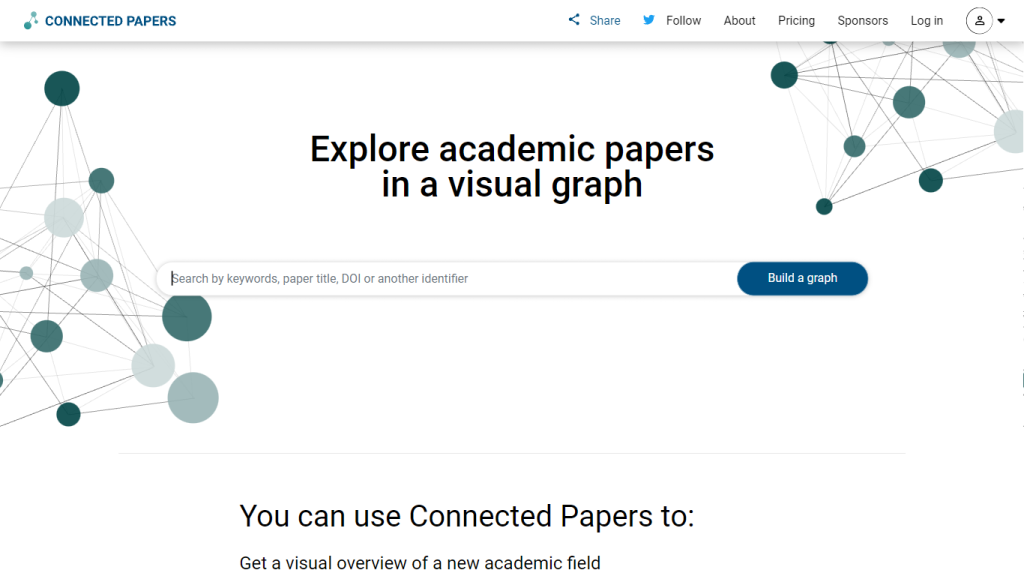What is Connected Papers?
Connected Papers is a singular visual tool that assists each researcher and practical scientist in finding and exploring academic papers of relevance to their fields. As a research and knowledge-sharing platform, the site supports scientists, researchers, and students in accessing updated research and insights into their topics of interest. It gathers in one online repository research papers and other academic material, then structures them into collections by topics and keywords in order to make the searching process much more intuitive and fast.
Key Features & Benefits of Connected Papers
Connected Papers boasts a lot of features that make it an indispensable tool to have for different types of users. It includes:
-
Visual Exploration:
To visually explore papers by navigating through an interconnected graph that visualizes the relations between papers. -
Paper Search:
The ability to find relevant research papers on any particular topic is efficient. -
Topic-based Organization:
Papers need to be organized under topics such that people will find things more relevant to their searches. -
Keyword Tagging:
The papers are allowed to be tagged with keywords to make searching easier. -
Collections:
Users can curate collections of papers that might relate to their needs for research. -
Content Sharing:
Seamless sharing of either collections or individual papers with working colleagues. -
Field-Specific:
Results of particular fields to which a user works. -
Up-to-Date:
Catch the recent studies and discussions which took place academically. -
Tracking the Evolution of Ideas:
Trace how ideas and related research have been developed over time.
Use Cases and Applications for Connected Papers
Having said that, Connected Papers can be used in a number of ways, as certain usages include:
-
Literature Reviews:
Find relevant research papers for a literature review. -
New Research Exploration:
Dive deeper into new research in a completely new field. -
Stay Current:
Keep tabs on the most recent scholarly content and trends within your domain.
An interdisciplinary platform that services the needs of a wealth of users, including but not limited to:
- Research Scientists
- Students
- Educators
- Writers
- Journalists
How to use Connected Papers
Getting started with Connected Papers only takes a few easy steps. I am going to walk through the process involved in using this great resource.
-
Sign Up:
Log in with Connected Papers. -
Search for Papers:
Just use the search to find papers relevant to your field. -
Explore Connections:
Take a look at the Connected Graph and see how various papers are interconnected. -
Create Collections:
Store the findings in the collections for further reference. -
Share and collaborate:
on your collection with colleagues or collaborators.
Following are some tips that can help you make the most out of Connected Papers:
- Provide specific keywords so that the results come according to your exact requirements.
- Keep updating your collection to include recent research in the relevant field.
- Avail of the visual graph to see the overview of the development of idea and concept.
How Connected Papers Works
Connected Papers deploys sophisticated algorithms and models in order to depict graphically how various academic papers are connected. More precisely:
-
Data Aggregation:
It aggregates data from different academic databases in order to make sure of the widest coverage. -
Graph Algorithm:
The system deploys a graph algorithm to map the relations among various papers. -
Keyword Analysis:
Analysis of keywords and topics for proper classification of the papers is important.
The general flow of all these activities is as under:
-
Data Collection:
This includes the process of collecting papers through various channels. -
Graph Construction:
It builds a visual graph by connecting related papers. -
Search and Filter:
It offers to search for and filter papers, as required by the users. -
Visualization:
The results from it are intuitive and visual.
Pros and Cons of Connected Papers
As much as Connected Papers have their advantages, there is a need to consider some potential drawbacks:
Pros
- An intuitive visual interface allows users to understand how research connects more easily.
- The Search and filtering options are numerous.
- It is updated regularly, meaning the latest available research is given to its users.
Cons
- This may result in a learning curve for new users.
- With the freemium pricing model, some of the advanced features may be locked away.
Overall, user feedback has been quite good-most in favor of its enabling simplification of the literature review process.
Conclusion about Connected Papers
In other words, Connected Papers is designed to be such a helpful hand for every researcher, scientist, or student to effectively manage his or her work of reviewing the literature. Its intuitive layout and visual nature are combined with strong features of search and organization, making it quite an asset. Besides, with continuous development, the platform will gradually offer more advanced features and cover more areas of academic content.
Whether new research or just the urge to keep up with your field, Connected Papers has an integrated solution to enrich your scholarly work.
Connected Papers FAQs
Frequently Asked Questions
-
Does Connected Papers cost anything to use?
Yes, Connected Papers is free to use. It is a freemium product. You can use the basic functionality for free, and the premium version requires a subscription. -
How does Connected Papers structure research papers?
It organizes research papers into graphical maps of topics and keywords, thereby making the connections between a variety of studies more understandable. -
Can I share my research collections with others?
Yes, you can share your collection with your colleagues or collaborators using Connected Papers. -
For what kind of users is Connected Papers designed?
The site will be helpful for researchers, scientists, students, educators, writers, and journalists.
More detailed guidance and troubleshooting hints could be looked upon on the Connected Papers help center or by contacting customer support.

